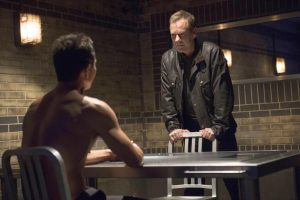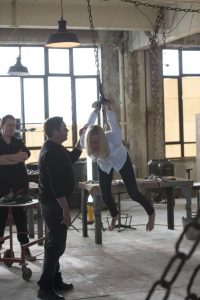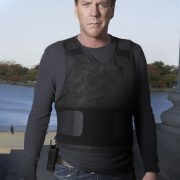I write violent stories. It’s hardly surprising that I enjoy violence in movies and on TV. Here’s a post on another of the antiheroes I’ve grown to love.
I never watched the series 24 while it was on TV. Then one evening I was casting about for something to pass the time on Amazon Prime and decided to try it. Big mistake. This series is like the popcorn at movie theaters. I generally avoid that popcorn — way too much salt, minimal nutritional value, and weird fake butter that smells like it could be carcinogenic — but once I start munching I finish the whole bucket. Same with 24. Caught in the relentless machinery of its suspense, I devoured every single episode of all eight seasons, plus the ninth one that aired last year.
 The series follows the exploits of Jack Bauer (Kiefer Sutherland), a former Special Forces guy working on and off for a government agency called the Counter-Terrorist Unit. Season after season he saves America from deadly terrorist threats in a world where the terrorists are all masterminds and the government functionaries who combat them are — with the exception of Jack and a few others — incompetent or corrupt. At first he comes off as such a straight arrow that more than one bad guy refers to him sneeringly as a Boy Scout.
The series follows the exploits of Jack Bauer (Kiefer Sutherland), a former Special Forces guy working on and off for a government agency called the Counter-Terrorist Unit. Season after season he saves America from deadly terrorist threats in a world where the terrorists are all masterminds and the government functionaries who combat them are — with the exception of Jack and a few others — incompetent or corrupt. At first he comes off as such a straight arrow that more than one bad guy refers to him sneeringly as a Boy Scout.
A Boy Scout with merit badges in assassination, carjacking, and torture.
Jack Bauer will do anything to complete his Mission. If he needs to persuade a white supremist gang of his bona fides, he shoots a prisoner and presents the guy’s severed head to the gang’s leader. Jack can be very cold. He’s ready to expose a terrorist’s innocent daughter to a horrific deadly virus to force the man to cooperate. And don’t piss him off. He’ll cut your guts out. Literally.
If Jack needs a vehicle to pursue a bad guy, he forces a random motorist from his car at gunpoint. Of course he says something like, “I need your car, sir,” or “I don’t want to shoot you,” instead of “Out of the car, bitch.” When you’re staring down the barrel of a semiautomatic, courtesy makes a lot of difference.
 Jack Bauer tortures suspects to obtain information despite the unreliability of torture as an interrogation technique. Even in the world of 24, it often fails to yield results. Jack himself is tortured repeatedly but never gives up information, not even during the nineteen months he spends in a Chinese prison camp. Some of the terrorists are equally tough. Yet the good guys and bad guys torture their enemies routinely because, what the hell, now and then it works. And Jack is always Running Out of Time and compelled to Do Whatever It Takes. In Season 6 he ends up in front of a Senate subcommittee investigating the illegal use of torture by the government — until the FBI borrows him to help fend off yet another terrorist threat and he interrogates a suspect with the help of a stun gun.
Jack Bauer tortures suspects to obtain information despite the unreliability of torture as an interrogation technique. Even in the world of 24, it often fails to yield results. Jack himself is tortured repeatedly but never gives up information, not even during the nineteen months he spends in a Chinese prison camp. Some of the terrorists are equally tough. Yet the good guys and bad guys torture their enemies routinely because, what the hell, now and then it works. And Jack is always Running Out of Time and compelled to Do Whatever It Takes. In Season 6 he ends up in front of a Senate subcommittee investigating the illegal use of torture by the government — until the FBI borrows him to help fend off yet another terrorist threat and he interrogates a suspect with the help of a stun gun.
 Despite his violent ways, I can’t help liking Jack Bauer. He’s an idealist willing to give his life, if necessary, to complete his Mission. The US government doesn’t bother rescuing him from the Chinese prison camp until a terrorist offers vital information in exchange for him. (He once tortured the terrorist’s brother to death and understandably the man wants payback.) Jack is okay with being tortured to death in a good cause. “It would be a relief,” he says. This is so sad that I can’t help feeling for him.
Despite his violent ways, I can’t help liking Jack Bauer. He’s an idealist willing to give his life, if necessary, to complete his Mission. The US government doesn’t bother rescuing him from the Chinese prison camp until a terrorist offers vital information in exchange for him. (He once tortured the terrorist’s brother to death and understandably the man wants payback.) Jack is okay with being tortured to death in a good cause. “It would be a relief,” he says. This is so sad that I can’t help feeling for him.
Jack is loyal to his friends and fiercely protective of his family. Not that he has many of either. The people close to him keep getting killed, starting with his wife in Season One. His daughter manages to stay alive, but much of the time she can’t stand being around him. She’s kind of a whiny brat anyway.
 So he battles his way through season after season, emptying countless clips of ammo into bad guys, becoming increasingly grizzled and stoic and lonely. His occasional private tears show that he understands how much his work is eroding his humanity. In the final season, I keep hoping he can retire at last and spend time with his granddaughter. Instead he meets a predictable unhappy fate. He gives himself up to the Russians to save the one friend he has left.
So he battles his way through season after season, emptying countless clips of ammo into bad guys, becoming increasingly grizzled and stoic and lonely. His occasional private tears show that he understands how much his work is eroding his humanity. In the final season, I keep hoping he can retire at last and spend time with his granddaughter. Instead he meets a predictable unhappy fate. He gives himself up to the Russians to save the one friend he has left.
Photos from FanPop.com








